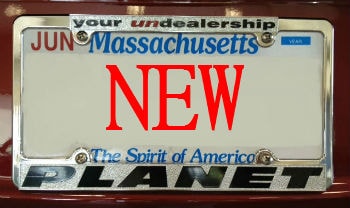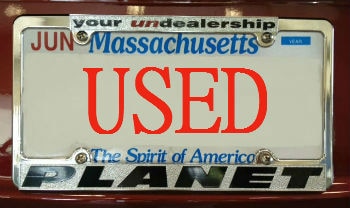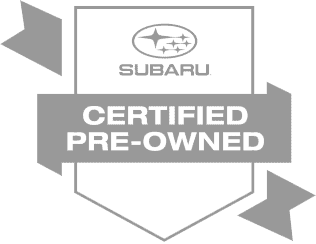 | This is a cutaway of the all wheel
drive system on Jeff's Siamese cat, Samantha. Can you imagine a cat with just front wheel drive? That would be about as ridiculous as buying a car that only powers two wheels when you could own a Subaru that powers all four for the same price. (If you like cat videos, click here to see a video of Jeff and his cats performing a rendition of Neil Diamond's Sweet Caroline). |
Symmetrical All Wheel Drive is standard on every Subaru vehicle except for BRZ. Most cars send engine power to the road through only the front wheels or only the rear wheels. When many people think of all wheel drive, they think only of the benefits they would enjoy in snow, and ice (which are very considerable!) But there are benefits in other conditions too:
- More control on perfectly dry pavement, especially during accident avoidance maneuvers.
- More control in rain, especially in hydroplane conditions where tires start riding on top of the water. Subaru AWD can pull power away from hydroplaning tires.
- More control during a tire blow out, because the all wheel drive system will pull power away from that wheel, reducing the likelihood of a skid.
- Longer lasting tires because they wear more uniformly since all the tires are working to move the car forward.
- Greater control while accelerating. In front-wheel drive cars, the front wheels have to steer and grab for traction, creating a creepy side-to-side tug in the steering wheel called "torque steer." In a rear wheel drive car, when the tires lose grip you experience a dangerous "fishtail" where the rear end starts whipping back and forth.
- Quicker acceleration. When you get on the gas, weight shifts from the front of the car to the back, lifting the front wheels off the ground and starving front drivers of road bite. Subaru AWD moves some of the torque to the rear, where more traction is available. The graphic below shows how the weight transfers. (It's just the opposite when you slam on the brakes and the nose dives.)

Why does Subaru call it symmetrical all wheel drive?
If you cut a Subaru drivetrain in half, lengthwise, then each side would weigh the same. They are essentially mirror images...symmetrical.
 |  |
How is "all wheel drive" different than "four wheel drive?"
Generally speaking, four wheel drive systems apportion power (or "torque") to each of the four wheels, regardless of whether any particular wheel has traction or not. Subaru AWD moves torque to the wheels that have grip and away from the ones that are starting to slip. Subaru's system can detect a slipping wheel in less than one revolution of that wheel...literally faster than the blink of an eye. When your Subaru detects slippage of a wheel, it pulls power away from that wheel, and redirects it to the wheels that still have traction.
Can your car do this?
We took this video at Planet Subaru after a storm. This is how we extricate cars from the snow. When we have to broom, move, and plow under 250 cars, we thank heavens for all wheel drive!
Does all wheel drive hurt fuel economy?
Yes, a little bit. Before 1997, when some Subarus were available
with front-wheel-drive, the AWD models were rated one mile
less per gallon. The all wheel drive hardware only adds about 150
pounds, so having all wheel drive is like having another person in your
car. But what a guy! If you could have an extra "passenger" that kept
you a lot safer under virtually every driving condition, you would want
him with you all the time! Make your next car a Planet Subaru and
you'll have a guardian angel riding shotgun.
One-minute video: Subaru AWD vs. a mere mortal two wheel drive car.
These models show the advantages of Subaru AWD over the systems from other brands.

Subaru's system: elegant, simple, and balanced
Advantages of Subaru AWD over other systems:
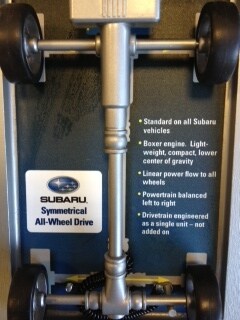
Subaru's system: elegant, simple, and balanced
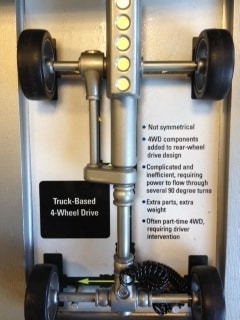 Truck based 4WD found on pickups and many SUV's | 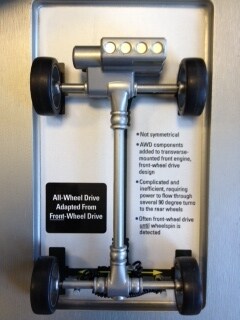 Vehicle originally developed for front wheel drive and then AWD added | 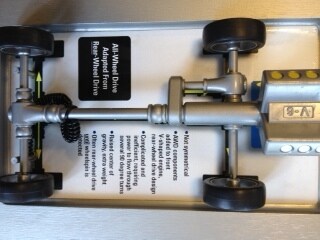 Vehicle originally developed for rear wheel drive and then AWD added |
Advantages of Subaru AWD over other systems:
- No buttons to push...by the time you hit a patch of ice, it's too late to push a button activating all wheel drive. Subaru's system is full-time.
- Because Subaru engineers its vehicles knowing that they will have all wheel drive, they can leave out heavy equipment that other manufacturers need to bolt on later. For example, Subaru's center and front differentials are integrated right into the transfer case, eliminating the need to add these heavy components later. Less weight, better handling, fewer parts, greater reliability.
- Subaru AWD not only moves power from front axle to rear axle, but can also move power left to right, wheel to wheel. That means you can have traction with only a single wheel and still get movin'! Many competing AWD systems can only move power axle to axle and not side to side.
- Subaru has many decades engineering these systems. Subaru's system is elegant, simple, and battle-tested.
One minute video comparing to Subaru AWD to other systems.
